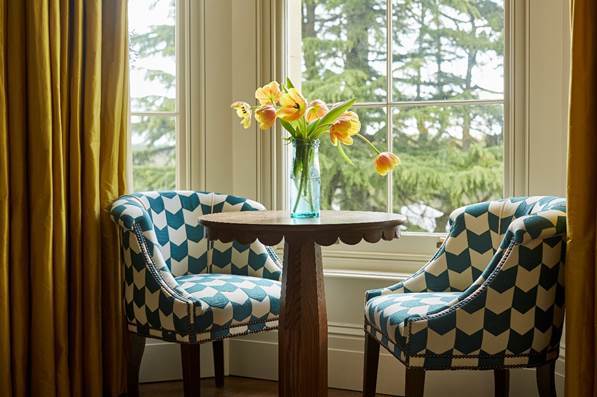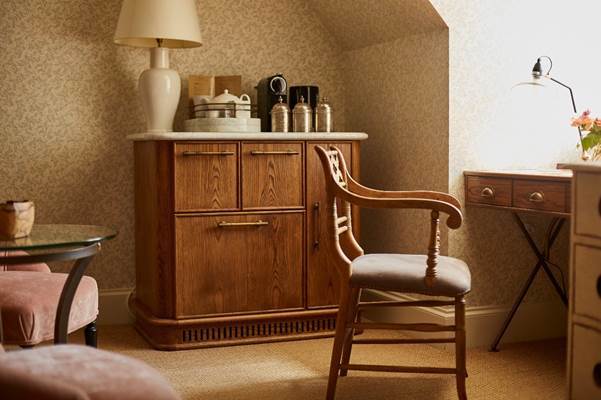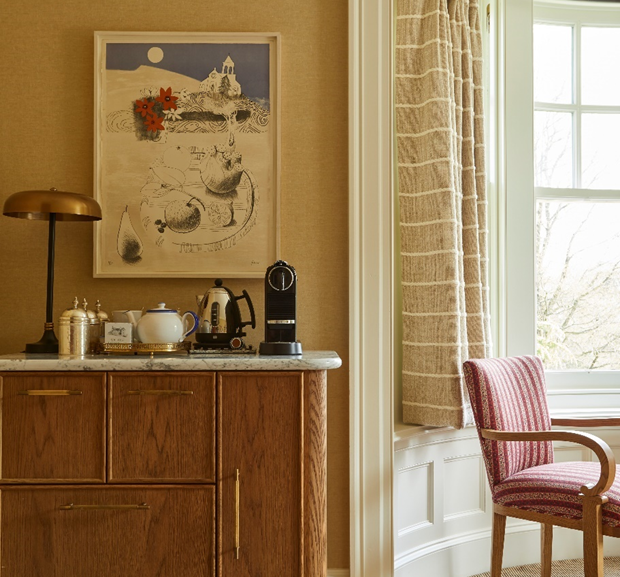
A Forager’s Winter Larder
Hear from Lime Wood’s resident forager, Sammie, about how to embrace the seasons through wild harvesting, herbal preparations, and creating your own winter larder.

We know just how much our guests love the interiors at Lime Wood – calm, characterful, and full of thoughtful details that make every space feel like home. We sat down with the brilliant interior designer behind it all, Susie Atkinson, to get the full Lime Wood Lowdown. From the influence of the New Forest to her approach to lighting, patterns, sustainability, and how you can bring a touch of Lime Wood magic into your own home, Susie shares the stories, style, and secrets behind our much-loved spaces.

How would you describe the interiors at Lime Wood in three words?
Lime Wood is welcoming, homely with an understated sophistication.
How pivotal was Lime Wood’s New Forest location when planning the hotel’s interiors, and did this influence your material and colour choices?
The surroundings of Lime Wood completely influenced the direction of the design. I like to spend time in a space before deciding how to decorate and style it, and I was keen to reflect the beauty of the setting without making any bold or overwhelming statements with the interiors. Instead, I focused on a calm colour palette and natural materials such as wool, linen, and silk, bringing in as much texture as possible to create a cosy, welcoming feel.
How does your approach differ when designing social spaces like The Drawing Room at Lime Wood compared to bedrooms and suites?
The Drawing Room is a special space – it has a wonderful bay window, beautiful natural light, and perfectly balanced proportions, plus a lovely fireplace, so we had an amazing starting point! I wanted it to feel glamorous and comfortable in the evening – a place to enjoy a cocktail – and equally inviting in the morning for reading the papers with a coffee.
I often have to remind myself to stay practical. When designing for a hotel, the rooms are used almost constantly, so we must choose materials that can withstand heavy use, potential spillages, and that comply with fire regulations. This can really limit the options, as these types of fabrics are often quite tough and can give off an "airport" or "waiting room" feel, which I wanted to avoid at all costs.
What role does lighting play in your design, and how did you approach it at Lime Wood?
Lighting is really important in a room, although I do think it can sometimes be overthought and end up far too complicated! My usual lighting "recipe" is as follows: pendant lights on one circuit, lamps on their own 5-amp circuit so they can all be switched on together when you enter a room, and wall lights on a separate circuit. All three circuits should have dimmers.
This setup allows for all the lights to be on when needed, or for a different mood to be created in the evenings by dimming just the lamps and/or wall lights to create a lovely atmosphere. Sometimes more focused lighting is required for specific artworks or sculptures, but this is my general approach. The essentials? Dimmers – and warm white light bulbs!

We love how prints play a big role in the interiors – what’s your approach to mixing patterns and textures while still maintaining calm and comfort?
I’ve always loved prints, especially florals. We actually have a basket in the studio filled with beautiful floral fabrics, and another with the “ugly” florals! The latter we use when we want to introduce pattern and colour without it feeling too pretty or “bedroomy.”
Mixing patterns can be tricky, but I usually try to introduce a stripe or checked fabric alongside a floral, or something with a geometric pattern to balance out the daintiness that florals can bring. Mixing several florals can work really well too, but it’s important to vary the scale of the prints – a large floral will mix nicely with a smaller-scale print so they don’t compete and read more harmoniously.
I also love adding textures, maybe with cushions or on an ottoman. Textured wool, very slubby linen, or boucle fabric work really well, and leather is great to introduce a smooth surface with a bit of reflective quality.

What’s your must-have element in any space you design?
Dimmers on the lights – always! It makes such a difference to the mood and flexibility of a space.
How do you blend sustainability with luxury in your design process?
We try to be as sustainable as we can. As a studio, we focus on working with as many British craftspeople as possible, often exploring a region for local makers before we even begin a project. It’s a complete highlight of my job to discover new people with brilliant skills, whether they’re weavers, ceramicists, upholsterers, basket makers, or others.
We prioritise natural materials, as I mentioned earlier, and it’s exciting to see new innovations emerging, like rugs made from recycled plastics that still feel beautifully soft. We also always try to include a few antique or mid-century pieces in a space. These add character and help avoid that overly “designed” look.
I recently attended a talk about the meaning of ‘luxury,’ and it really resonated with me. Luxury means different things to different people, but for me, it’s about knowing and understanding where something comes from, who made it, appreciating how it was made, and celebrating the creativity and skill behind it.

Is there a particular design trend that you’re excited to explore or see evolve in the future?
There are always new things landing on my desk, which I love! It’s like Christmas every day. I try to stay away from trends, although of course, we’re all influenced by what we see on social media. I focus on ideas that I think will stand the test of time.
It’s interesting to see the current trend for checked fabrics – both in fashion and interiors – but for me, checks have always been part of my schemes. They’ve been used traditionally for centuries, so they never really feel like a trend to me.
What I’m most excited about at the moment is the explosion of outdoor fabrics, furniture, and carpets. Getting out into nature is so important, and if we can be made as comfortable as possible outside, with fire pits, rugs, and beautiful furniture, then bring it on!
What’s the most rewarding aspect of seeing your design come to life in such a special setting like Lime Wood?
My job is incredibly rewarding, especially in terms of the people I get to meet, whether it’s makers, craftsmen, the on-site team, or clients. No two days are ever the same. I find it fascinating to see all the different roles that come together to make a hotel like Lime Wood run so smoothly – it’s a huge task to get right.
I like to think I add a little icing on the cake, making things look inviting, interesting, and hopefully creating interiors that are memorable for everyone who visits.

Do you have a favourite room or hidden corner of Lime Wood?
My favourite room is, without doubt, Pavilion One. It’s tucked close to the forest and has a stunning domed ceiling. We used Mythical Land wallpaper by Andrew Martin, which really immerses you in the woodland setting. The bath is set within a bay, and the chic blinds roll up to reveal the trees outside – it’s an absolutely fabulous place to stay.
If guests could take one design tip from Lime Wood to use at home, what would it be?
Don’t worry about mixing antiques with new furniture – it really adds character to a room and stops it from feeling too sterile. Old and new pieces can work beautifully together!
Book one of Susie’s beautifully designed rooms at Lime Wood
Want to see more of Susie’s designs?
Website: www.studio-atkinson.com
Instagram: @studio_atkinson

Hear from Lime Wood’s resident forager, Sammie, about how to embrace the seasons through wild harvesting, herbal preparations, and creating your own winter larder.
There’s a special kind of magic at Curated during the festive season. To help inspire your Christmas gifting, our team has gathered a few of their favourite pieces this season.

Delve beneath the surface (literally) to explore the fascinating world of microbiomes with Peigin Crowley, founder of Ground Wellbeing